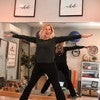Premium Continuing Education workshop
You can view a 2 minute preview. For details, scroll down below the video.
Description
Objectives
- Learn about the natural squat and how humans used to use this position for many activities
- Learn about the compensations that develop from sitting and how we can help improve these restrictions
- Learn about ergonomics and how it has impacted our bodies and productivity
About This Video
Continuing Education Credits
If you complete this workshop, you will earn:
2.0 credits from Pilates Association Australia (PAA)
The Pilates Association Australia (PAA) is an independent and not-for-profit organization established by the Pilates industry as a regulatory body for control of quality instruction, member support, and integrity within all legitimate approaches to the Pilates Method.
3.0 credits from National Pilates Certification Program (NPCP)
The National Pilates Certification Program is accredited by the National Commission for Certifying Agencies (NCCA)
Workshops: Body Pathologies and Conditions
Comments
Linda ~ We are sorry that you had trouble with the videos, but we're glad you are enjoying this workshop. You may need to try a lower video quality to help the videos stream better. Here is a link to our video troubleshooting tips. If you continue to have trouble after trying these, please email us at support@pilatesanytime.com.
I really appreciate Pilates Anytime offering such high CEC quality workshops. Would it be possible to share the topics the quiz will cover before hand? The questions were fine, but when there is so much covered and when we each engage with these workshops using our own authentic lens, a range of ideas resonate and seem important. I might have focused on one piece of a section, while the quiz seemed to emphasize another. So, a quick list of topics might be helpful for participants to prepare for the quiz. Thanks!

You need to be a subscriber to post a comment.
Please Log In or Create an Account to start your free trial.





















